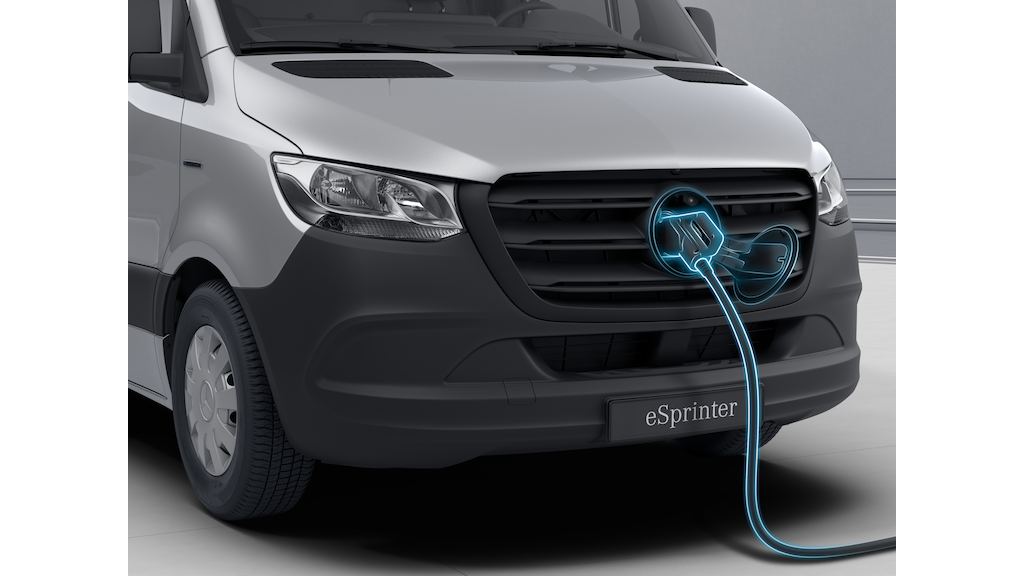Software retrofit for faster DC charging (E6L), Sprinter, A0008276700
€733.11
Our payment methods:
Product number: A0008276700
Width: 1 mm
Height: 1 mm
Weight: 0.02 kg
Our benefits
- Experience since 1961
- Mercedes certified
- Customer satisfaction "very good"
- SSL encryption
- Climate-neutral shipping
For Series: BR910 Sprinter (06/18- )
Product information "Software retrofit for faster DC charging (E6L), Sprinter, A0008276700"
Expand the functionality of your Mercedes-Benz eSprinter in the simplest way possible.
Your Mercedes-Benz eSprinter adapts to changing requirements.
Fast, professional and cost-effective.
With the software retrofit for faster DC charging from Mercedes-Benz, you have the option of adapting your electric van to your individual needs, even retrospectively. The increased DC charging power (direct current battery charging) significantly reduces your charging time compared to standard DC charging.
The advantages at a glance:
With the increased DC charging power of up to 80 kW, the standard high-voltage battery (35 kWh) of the Mercedes-Benz eSprinter can be charged from 10% to 80% in just around 20 minutes at a DC fast-charging station.
What does fast charging mean?
Increasing the DC charging capacity by retrofitting the software in your Mercedes-Benz eSprinter enables you to charge even larger quantities in less time via the Combined Charging System (CCS). Thanks to the Combined Charging System (CCS), you can charge the Mercedes-Benz eSprinter flexibly at charging stations and wallboxes with alternating current (AC) or direct current (DC).
What is the difference between AC and DC charging?
The battery is always charged with direct current (DC), as it is directly available at DC fast-charging stations. With high charging power, range can be gained quickly.
When AC charging at public charging stations or the wallbox at home, alternating current (AC) in the vehicle is converted into direct current by an AC on-board charger and then fed into the battery.
Mercedes-Benz Wallbox Home
Fast, safe and convenient charging - with the Mercedes-Benz Wallbox Home.
The
Your Mercedes-Benz eSprinter adapts to changing requirements.
Fast, professional and cost-effective.
With the software retrofit for faster DC charging from Mercedes-Benz, you have the option of adapting your electric van to your individual needs, even retrospectively. The increased DC charging power (direct current battery charging) significantly reduces your charging time compared to standard DC charging.
The advantages at a glance:
With the increased DC charging power of up to 80 kW, the standard high-voltage battery (35 kWh) of the Mercedes-Benz eSprinter can be charged from 10% to 80% in just around 20 minutes at a DC fast-charging station.
What does fast charging mean?
Increasing the DC charging capacity by retrofitting the software in your Mercedes-Benz eSprinter enables you to charge even larger quantities in less time via the Combined Charging System (CCS). Thanks to the Combined Charging System (CCS), you can charge the Mercedes-Benz eSprinter flexibly at charging stations and wallboxes with alternating current (AC) or direct current (DC).
What is the difference between AC and DC charging?
The battery is always charged with direct current (DC), as it is directly available at DC fast-charging stations. With high charging power, range can be gained quickly.
When AC charging at public charging stations or the wallbox at home, alternating current (AC) in the vehicle is converted into direct current by an AC on-board charger and then fed into the battery.
Mercedes-Benz Wallbox Home
Fast, safe and convenient charging - with the Mercedes-Benz Wallbox Home.
The
Properties "Software retrofit for faster DC charging (E6L), Sprinter, A0008276700"
| Series: | BR910 Sprinter (06/18- ) |
|---|
Data according to manufacturer. Errors and changes reserved.
Code-Regel: ( +ME0 ) and ( +XZ0 )
| Code | Kennzeichen | Bezeichnung |
|---|---|---|
| ME0 | mit | Elektromotor 85 kW |
| XZ0 | mit | Modellgeneration 0 |
Code-Regel: ( +ME0 ) and ( +XZ0 )
| Code | Kennzeichen | Bezeichnung |
|---|---|---|
| ME0 | mit | Elektromotor 85 kW |
| XZ0 | mit | Modellgeneration 0 |
Code-Regel: ( +ME0 ) and ( +XZ0 )
| Code | Kennzeichen | Bezeichnung |
|---|---|---|
| ME0 | mit | Elektromotor 85 kW |
| XZ0 | mit | Modellgeneration 0 |
Code-Regel: ( +ME0 ) and ( +XZ0 )
| Code | Kennzeichen | Bezeichnung |
|---|---|---|
| ME0 | mit | Elektromotor 85 kW |
| XZ0 | mit | Modellgeneration 0 |
Code-Regel: ( +ME0 ) and ( +XZ0 )
| Code | Kennzeichen | Bezeichnung |
|---|---|---|
| ME0 | mit | Elektromotor 85 kW |
| XZ0 | mit | Modellgeneration 0 |
Code-Regel: ( +ME0 ) and ( +XZ0 )
| Code | Kennzeichen | Bezeichnung |
|---|---|---|
| ME0 | mit | Elektromotor 85 kW |
| XZ0 | mit | Modellgeneration 0 |
Code-Regel: ( +ME0 ) and ( +XZ0 )
| Code | Kennzeichen | Bezeichnung |
|---|---|---|
| ME0 | mit | Elektromotor 85 kW |
| XZ0 | mit | Modellgeneration 0 |
Code-Regel: ( +ME0 ) and ( +XZ0 )
| Code | Kennzeichen | Bezeichnung |
|---|---|---|
| ME0 | mit | Elektromotor 85 kW |
| XZ0 | mit | Modellgeneration 0 |
Code-Regel: ( +ME0 ) and ( +XZ0 )
| Code | Kennzeichen | Bezeichnung |
|---|---|---|
| ME0 | mit | Elektromotor 85 kW |
| XZ0 | mit | Modellgeneration 0 |
Code-Regel: ( +ME0 ) and ( +XZ0 )
| Code | Kennzeichen | Bezeichnung |
|---|---|---|
| ME0 | mit | Elektromotor 85 kW |
| XZ0 | mit | Modellgeneration 0 |
Code-Regel: ( +ME0 ) and ( +XZ0 )
| Code | Kennzeichen | Bezeichnung |
|---|---|---|
| ME0 | mit | Elektromotor 85 kW |
| XZ0 | mit | Modellgeneration 0 |
Code-Regel: ( +ME0 ) and ( +XZ0 )
| Code | Kennzeichen | Bezeichnung |
|---|---|---|
| ME0 | mit | Elektromotor 85 kW |
| XZ0 | mit | Modellgeneration 0 |
Code-Regel: ( +ME0 ) and ( +XZ0 )
| Code | Kennzeichen | Bezeichnung |
|---|---|---|
| ME0 | mit | Elektromotor 85 kW |
| XZ0 | mit | Modellgeneration 0 |
Code-Regel: ( +ME0 ) and ( +XZ0 )
| Code | Kennzeichen | Bezeichnung |
|---|---|---|
| ME0 | mit | Elektromotor 85 kW |
| XZ0 | mit | Modellgeneration 0 |


